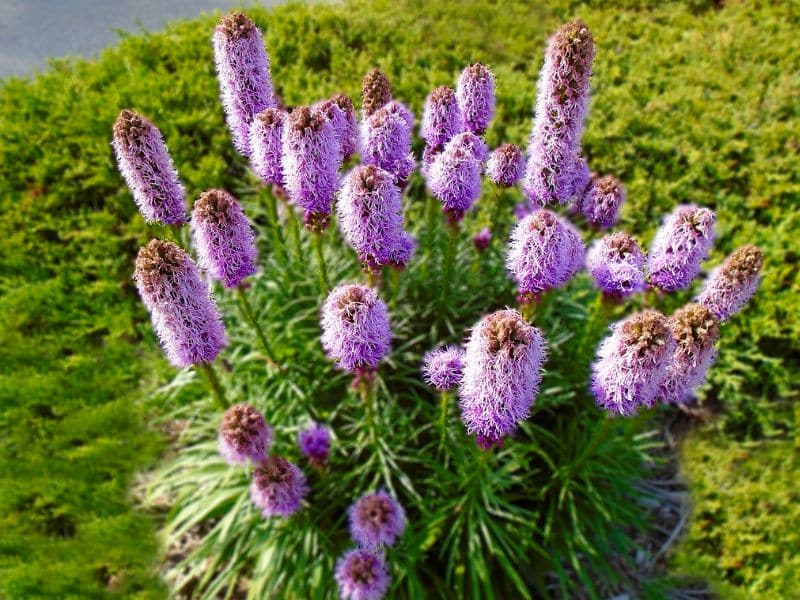Liatris (Liatris spicata), also known as blazing star, gayfeather, or prairie star, is the perfect ornamental plant to include in your garden if you want something to attract attention. These beautiful flowering plants produce vivid clump blooms on strikingly tall spikes. These flowers are mostly purple, but some have pink or white flowers.
This plant’s tall, spiky flowers will look especially charming if you combine them with companion plants like New England asters, oxeye sunflowers, daylilies, lambs ear, or hyssop-leaf thoroughwort.
In this guide, we are going to take a closer look at these blazing star companions, and we are going to share some creative ways to use and combine them in your garden bed.
What to Grow with Liatris

Suppose you want your flowers to bloom excessively in mid-summer to attract butterflies and hummingbirds to your garden. In that case, combining plant species with a similar growing season and requirements is best.
Blazing star plants grow best if established in full sun and won’t bloom in a shaded position. These perennial plants prefer light soil types that drain well, and they shouldn’t be watered too often because they are drought-tolerant.
Let’s look at a couple of good liatris companions that can handle the same dry, sunny, and warm conditions that these flowers require.
New England Aster

New England Asters (Symphyotrichum puniceum) or Michaelmas daisies can be terrific companion plants for liatris if you want to create a purple-toned garden bed. These perennials produce striking blooms in shades of purple and pink that will complement your liatris flower stalks very well when both are in full bloom.
These aster family members need to be planted in full sun with a minimum of 6 – 8 hours of direct sunlight. They should be established in well-draining soil, and they should only be watered once a week if it doesn’t rain because they can develop root rot if grown in moist soil.
Michaelmas daisies can grow rather bushy. The plant can reach up to 6 feet, but most will only grow up to 4 feet in height. Because these flowering shrubs can become so tall, it is usually best to position your liatris spicata flowers in the front of your garden bed or bunches next to your daisy bushes.
Ox-Eye Sunflower

Oxeye sunflowers (Heliopsis helianthoides), rough oxeye, smooth oxeye, or false sunflowers are perfect liatris companion plants to create a striking contrast in your garden bed. These vivid yellow flowers attract butterflies and bees and offer lots of charm with their bright colors.
Smooth oxeye is a drought-resistant plant that only needs to be watered once a week. This flower prefers a full sun position, but it can survive in light shade. You will, however, get more flowers if these liatris companion plants are positioned in direct sunlight. False sunflowers can tolerate most soil conditions as long as it drains well.
These herbaceous perennials can grow up to 6 feet, while Liatris spicata will only grow up to 3 feet tall. Because of their height difference, it is best to include the yellow flowers in the background with your purple blazing star flowers in the front of your garden bed.
Daylily

Daylilies (Hemerocallis) can be good companion plants to add color to your garden. These flowers come in a huge variety of flower colors, including yellow, orange, red, maroon, and blackish red, and there are even some mixed-color varieties.
Even though daylilies are perennials, these bulb plants are often treated as annuals because their foliage will die back during winter. In colder regions, gardeners often extract the bulbs to store them for winter, but in warmer areas, it is perfectly safe to leave your bulbs in the ground so they can resurface next spring.
These beautiful flowers should be grown in a full sun position. They prefer free-draining soil and need more frequent watering during their blooming season.
Daylilies have a similar foliage structure to blazing star plants and are similar in height. Because of these similarities, you can quickly grow them next to one another to create a showy border or mixed hedge.
Lamb’s Ear

Gardeners often pair lambs ear (Stachys byzantine) or woolly hedgenettle with liatris spicata because the velvety soft silvery green foliage can add a lot of texture and color to your garden bed. These perennials produce purple flowers on tall spikes, but they are primarily grown for their attractive foliage. They are also evergreens and will keep your garden bed nice and full when the liatris flowers die back during winter.
Lamb’s ear will grow healthy and strong if you place it in free-draining soil, but it is important to leave the fertilizer out since these foliage species prefer poor or average soil conditions. The wooly plant can be grown in full sun to partial shade, and it is quite drought-resistant.
One of the most important things to remember about these velvety plants is that they don’t like water on their leaves. If the leaves are frequently watered, the plant will look unappealing.
This companion plant will look fantastic if you position it as a border before your liatris flowers. The velvety leaves will create a lot of contrast with the rest of your lawn and complement the bright liatris flowers.
Hyssop-leaf Thoroughwort
Hyssopleaf thoroughwort (Eupatorium hyssopifolium) is a good flowering species to include when planting liatris because it will add lots of texture and color to your garden with its delicate flower clusters. This perennial wildflower‘s pink or white blooms will give your garden a very soft appearance, and the plant is great for filling out your garden bed.
These attractive flowers should be planted in direct sun with free-drained soil, and while they can tolerate different soil types, they prefer sandy soil. As with most of the other plants on our list, this companion plant prefers dry to medium-dry conditions and shouldn’t be watered too often.
Gardeners love to combine these two plants all over their garden beds because the pink or white hyssopifoliums will add lots of texture and will fill out the garden bed. At the same time, the spiky purple liatris flowers will look wonderful as they peek out from here and there amongst the masses of tiny white flowers.
What NOT to Grow with Liatris
Since liatris flowers prefer direct sun and dryer conditions, it is usually best not to combine them with shade-loving plant species like ferns, hostas, begonias, and caladiums.
Some gardens also advise avoiding pairing these perennials with other plants that die back in the winter because this can leave you with an empty and unattractive garden space during the year’s colder months.
You should also avoid planting liatris underneath tall trees or shrubs that form a thick canopy because these flowers are prone to diseases without direct sunlight.

Landscaping Ideas for Liatris and Companions
Now that you know more about the best liatris companion plants, it is time to discuss different ways to use them in your garden. Here is a quick look at some creative gardening concepts to consider for your garden.
Xeriscape or Water Efficient Gardens
Most of the plants we discussed in this guide require very little maintenance. They are drought-tolerant and can handle a lot of heat and direct sun. These characteristics make them ideal candidates for xeriscape gardens or dry gardens.
You can combine vivid flowering species like oxeye sunflowers, New England asters, and liatris spicata in your garden bed, along with other natural features like stone boulders, attractive tree stumps, and river rocks or gravel as ground cover. This will create a very striking wildflower effect with lots of vertical interest and will result in a water-efficient space that is very easy to maintain.
Mixed Flower Beds or Borders
Liatris can be paired with other striking companion plants like false sunflowers, daylilies, hyssop-leaf thoroughwort, and other florals to create showy mixed garden beds or showy mixed borders. You can edge these mixed garden beds off with a row of lambs ears to create some structure around these garden features.
Mixed Containers
The liatris plant can grow well in containers, but you will need to water container plants more frequently than garden plants.
Liatris will form a showy thriller plant in a container. You can pair it with a shorter filler plant species like lambs ear to fill out the container and add some contrast so the purple flower stalks will stand out even more.
Final Thoughts
Gardeners can plant liatris with a wide range of companion species like New England asters, false sunflowers, daylilies, lamb’s ear, and hyssop-leaf thoroughwort to create stunning flowering gardens.
This guide gave you some ideas on new plants to include in your garden bed to create spaces ideal for attracting butterflies and other charming pollinating insects to your garden spaces.
See more:







